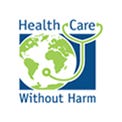Ending forced labor in health care supply chains
Health system leads on protecting workers
From Pakistani children sharpening surgical scalpels in grimy workshops to debt-bonded Bangladeshi migrants manufacturing disposable gloves, forced labor has long been an insidious part of the convoluted global supply chains that provide vital medical equipment.
Now, U.S. health care giant CommonSpirit Health wants its pledge to “do no harm” to permeate its entire supply chain and ensure no workers — whether making high-tech medical devices or growing cotton for its gauze and gowns — are victims of exploitation.
“We really need to remember there is a worker whose life is impacted by the purchasing decisions we make”
— Petra Linden, CommonSpirit director of international health and human trafficking
“We really need to remember there is a worker whose life is impacted by the purchasing decisions we make,” said Petra Linden, director of international health and human trafficking for CommonSpirit, which has 137 hospitals and 1,000-plus care centers. “If we talk about doing no harm to our patients, we also don’t want to do any harm to the workers who are producing the products that our patients are benefitting from.”
Despite their massive buying clout, labor experts say that unraveling supply chains is a long and complex process for health care systems that should work closely with vendors and heavyweight group purchasing organizations (GPOs) to make a significant impact.
Educating staff and suppliers to identify risk areas, implementing contractual clauses outlawing unfair labor practices, and working with suppliers to improve conditions are the initial steps for CommonSpirit, whose annual spend is $7.6 billion.
“It is our responsibility not simply to purchase from our suppliers but to find out geographically where their manufacturers are located and to ask more about that piece of work on the ground.”
— Kathryn Carpenter, CommonSpirit vice president for sourcing, contracting, and clinical strategy
“It is our responsibility not simply to purchase from our suppliers but to find out geographically where their manufacturers are located and to ask more about that piece of work on the ground,” said Kathryn Carpenter, CommonSpirit’s system vice president for sourcing, contracting, and clinical strategy.
High-volume products, like cotton and latex, are just the starting point, she said, adding the COVID-19 pandemic risked worsening conditions for workers making medical supplies as unscrupulous employers tried to satisfy soaring demand.
‘Deception, fraud, and corruption’
Labor experts say Thailand, Malaysia, and Taiwan are some of the biggest hotspots that manufacture medical supplies from electronics to clothing and rely on vulnerable migrant workers.
Last year, Malaysia’s Top Glove Corp hit the headlines when the United States banned shipments of its rubber gloves after uncovering forced labor and debt bondage at its facilities, where thousands of workers later caught COVID-19.
“The whole issue of forced labor is basically characterized by deception, fraud, and corruption… but it’s not impossible to get to the bottom of it,” said an international labor expert who spoke on the condition of anonymity.
“We often say to companies you don’t have to boil the ocean to figure out what’s happening. If you take a risk-based approach to your screening and assessment, you’ll be able to figure out what’s happening on the ground.”
He advises companies to fully map supply chains, use experienced auditors with local language skills to check worker conditions, and insist on contractually enforceable agreements that hold suppliers responsible for rooting out unfair practices.
In common forced labor situations, workers from countries like Nepal or Bangladesh are promised jobs abroad but have to pay recruitment agents fees of up to $5,000, amounts they often raise through high-interest loans, he explained.
On arrival, they find the reality is often far from what they were promised. Their passports are often confiscated and they are forced to work long hours while living in cramped dormitories.
Earning just a few dollars a day, they are effectively trapped and have to work for years just to pay off their crushing debts.
Breaking the chain
Rewriting its supply contracts to prohibit child and forced labor in the production of the thousands of items it buys — some of which pass through opaque layers of sub-contractors — is the starting point for CommonSpirit, Linden said.
Suppliers are also required to fill out questionnaires asking about their training programs and audits. They have to explain how they are protecting workers at the lower tiers of the production process where exploitation is most likely.
The next step for CommonSpirit, the biggest nonprofit health system in the United States, is to develop comprehensive standards and set up training programs for suppliers to help them identify risk areas — from raw materials to components and finished items.
Instead of branding suppliers complicit if they find factory workers paying recruitment fees or having their passports confiscated, CommonSpirit said it wants suppliers to be open so they can work together to improve conditions.
“We’re looking to implement a system, so we’re not just targeting one product but working with all our suppliers so there’s prevention in place,” Linden said.
Severing supplier contracts risks pushing unfair practices underground and forcing manufacturers to fire staff which would leave migrant workers stranded and unable to repay the onerous loans they took out to secure the job, warned the anonymous labor expert.
Formed in 2019 from the merger of Dignity Health and Catholic Health Initiatives, CommonSpirit is now looking to extend its annual training schemes for procurement staff around high-risk products to all of its employees.
Eventually, Linden hopes the momentum CommonSpirit is ramping up will have an industry-wide impact by encouraging other providers and GPOs, like its own Premier Inc., to set out stringent standards that force suppliers to clean up their act.
“If we can truly do this in a good way, then suddenly someone is not in forced labor anymore, they have freedom of movement,” she said.
